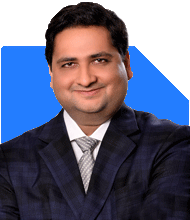When Will I Achieve Financial Independence?
Ramalingam Kalirajan |10908 Answers |Ask -Follow
Mutual Funds, Financial Planning Expert - Answered on Aug 21, 2024
He has an MBA in finance from the University of Madras and is a certified financial planner.
He is the director and chief financial planner at Holistic Investment, a Chennai-based firm that offers financial planning and wealth management advice.... more

I am 30 having one sip 55k per month paragh parik direct growth started this from last one year and have gold bonds of 100 gms when i can get financial independence
Evaluating Your Investment Strategy
SIP Investment: You are investing Rs 55,000 monthly in a mutual fund. This consistent investment will help you build a significant corpus over time.
Gold Bonds: Holding 100 grams of gold bonds adds stability to your portfolio. Gold is a safe asset, especially during economic uncertainty.
Both investments are solid choices, but you need a diversified approach to achieve financial independence.
Considerations for Financial Independence
Financial independence means having enough money to cover your expenses without relying on active income. To achieve this, consider these factors:
1. Target Corpus for Financial Independence
Estimate your monthly expenses, including future inflation.
Multiply your monthly expenses by 300 to 400. This will give you a rough estimate of the corpus you need.
Adjust your investments to match this target. This corpus should generate enough returns to cover your expenses.
2. Diversification for Stability and Growth
While SIPs and gold are excellent investments, consider diversifying further. Add debt funds or fixed income securities to balance your portfolio.
Diversification reduces risk and ensures stable growth. It also protects against market volatility.
Avoid putting too much money into one asset class. Balance between equity, debt, and gold.
3. Reviewing the Direct Fund Investment
You have invested in a direct mutual fund. Direct funds often have lower expenses but may lack guidance from a Certified Financial Planner (CFP).
Without professional advice, you might miss opportunities to optimize your returns. It’s essential to assess if you are maximizing your investment’s potential.
Consider switching to a regular plan with the help of a CFP. This will ensure your investments align with your long-term goals.
Planning for Future Goals
To achieve financial independence, it's crucial to plan for future needs and unexpected expenses. Here’s how:
1. Emergency Fund
Ensure you have an emergency fund. It should cover at least 6 to 12 months of living expenses.
This fund should be easily accessible and kept in a liquid fund or a savings account.
An emergency fund protects you from unexpected financial shocks without disturbing your investments.
2. Retirement Planning
Even if financial independence is your primary goal, plan for retirement. Consider how much money you need after retirement and adjust your investments accordingly.
Calculate how much you need to save monthly to reach your retirement corpus. This will ensure you can maintain your lifestyle after retiring.
Use retirement-specific funds or products that offer tax benefits and stable returns.
3. Insurance Coverage
Adequate insurance is crucial. Ensure you have term insurance and health insurance to protect your family and assets.
Term insurance offers financial security to your family in case of unforeseen circumstances.
Health insurance covers medical expenses, protecting your savings and investments.
Steps to Achieve Financial Independence
Now that you understand your current position and future needs, here’s a step-by-step plan:
1. Set Clear Financial Goals
Define what financial independence means to you. It could be retiring early, pursuing a passion, or spending more time with family.
Calculate your target corpus based on your goals. Consider future expenses like children’s education, healthcare, and lifestyle changes.
2. Increase Investment Contributions
If possible, increase your SIP contributions gradually. This will accelerate your wealth creation.
Consider adding more funds to your portfolio to enhance diversification. This ensures consistent growth with balanced risk.
Review your SIP performance annually and adjust if needed.
3. Regular Portfolio Review
Conduct a portfolio review every six months. Check if your investments are on track to meet your goals.
Rebalance your portfolio if necessary. If one asset class grows significantly, adjust it to maintain balance.
Consult with a Certified Financial Planner to get professional advice. This ensures your investment strategy aligns with your goals.
4. Monitor Lifestyle Inflation
As your income increases, avoid increasing expenses unnecessarily. This is known as lifestyle inflation.
Keep your expenses in check and invest the surplus income. This will help you reach financial independence faster.
Focus on saving and investing wisely rather than increasing your lifestyle costs.
Final Insights
You are on the right path with your current investments. However, to achieve financial independence, consider diversifying your portfolio and increasing your investment contributions. Regularly review your investments and consult with a Certified Financial Planner to ensure you are on track. With discipline and careful planning, financial independence is within your reach.
Best Regards,
K. Ramalingam, MBA, CFP,
Chief Financial Planner,
www.holisticinvestment.in
You may like to see similar questions and answers below
Hardik Parikh | Answer |Ask -Follow
Tax, Mutual Fund Expert - Answered on Apr 11, 2023
Ramalingam Kalirajan |10908 Answers |Ask -Follow
Mutual Funds, Financial Planning Expert - Answered on Jul 18, 2024
Reetika Sharma |432 Answers |Ask -Follow
Financial Planner, MF and Insurance Expert - Answered on Sep 10, 2025
Reetika Sharma |432 Answers |Ask -Follow
Financial Planner, MF and Insurance Expert - Answered on Aug 27, 2025
Ramalingam Kalirajan |10908 Answers |Ask -Follow
Mutual Funds, Financial Planning Expert - Answered on Sep 08, 2025
Ramalingam Kalirajan |10908 Answers |Ask -Follow
Mutual Funds, Financial Planning Expert - Answered on Dec 20, 2025
Ramalingam Kalirajan |10908 Answers |Ask -Follow
Mutual Funds, Financial Planning Expert - Answered on Dec 20, 2025
Naveenn Kummar |237 Answers |Ask -Follow
Financial Planner, MF, Insurance Expert - Answered on Dec 20, 2025
Ramalingam Kalirajan |10908 Answers |Ask -Follow
Mutual Funds, Financial Planning Expert - Answered on Dec 19, 2025
Nayagam P P |10859 Answers |Ask -Follow
Career Counsellor - Answered on Dec 19, 2025
Ramalingam Kalirajan |10908 Answers |Ask -Follow
Mutual Funds, Financial Planning Expert - Answered on Dec 19, 2025
Ramalingam Kalirajan |10908 Answers |Ask -Follow
Mutual Funds, Financial Planning Expert - Answered on Dec 19, 2025
Ramalingam Kalirajan |10908 Answers |Ask -Follow
Mutual Funds, Financial Planning Expert - Answered on Dec 19, 2025
Radheshyam Zanwar |6751 Answers |Ask -Follow
MHT-CET, IIT-JEE, NEET-UG Expert - Answered on Dec 19, 2025
Radheshyam Zanwar |6751 Answers |Ask -Follow
MHT-CET, IIT-JEE, NEET-UG Expert - Answered on Dec 19, 2025

























